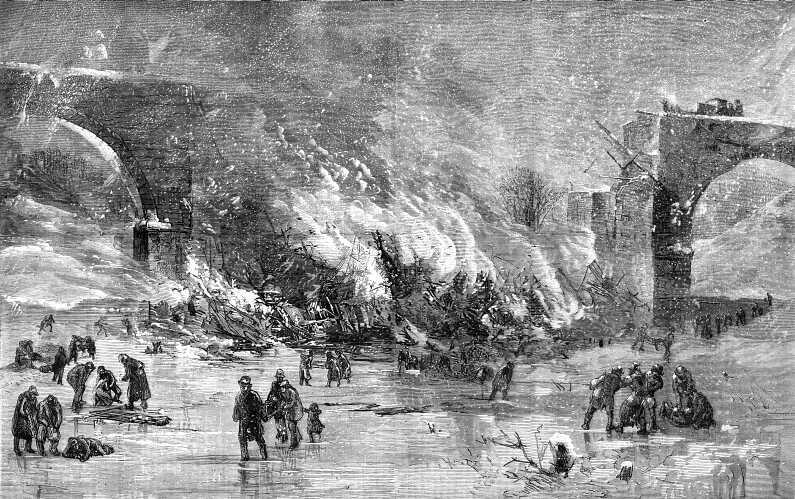The Lake Shore and Michigan Southern Railway Train No. 5, The Pacific Express, left Erie, Pennsylvania, on the afternoon of December 29, 1876 in deep snow. Two locomotives, "Socrates" and "Columbia", were hauling 11 railcars, including two express cars, two baggage cars, one smoking car, three coaches, and three sleeping cars that carried 159 passengers.
At about 7:30 pm the train was crossing over the Ashtabula River about 1,000 feet (300 m) from the railroad station at Ashtabula, Ohio when the bridge gave way beneath it.
The lead locomotive made it across the bridge, while the second locomotive and the rest of the train plunged 76 feet (23 m) into the water. Some cars landed in an upright position. The wooden cars were set alight by the heating stoves and lamps and soon small, localized fires became an inferno.

Of 159 passengers and crew on board that night, 92 were killed or died later from injuries; they included the gospel singer and hymn-writer Philip Bliss and his wife. Forty-eight of the fatalities were unrecognizable or consumed in the flames. Sixty-four people were injured.
The crash was heard in the town and the alarm was raised. By the time the townspeople reached the bridge the wounded passengers had made their way to the shore and the fire was burning fiercely.
When the Ashtabula Fire Brigade arrived, the immediate instructions from railroad employees were to get the wounded out and to clear a pathway up the side of the ravine. After this no water was put onto the fire, even after reports of survivors still trapped in the wreck.
The survivors were led, carried and conveyed on sleds to hotels and private houses in the town, there being no hospital.
However, people assisting also stole money and valuables from the survivors and dead, $1,500 (about 33,000 dollars today) being returned following investigation by detectives and after the mayor had made a proclamation.
The dead were moved the following morning. The railroad bridge was re-built with temporary underpinning.
The following day an investigative coroner's jury, made up of six men, was appointed. Their investigation was to take 68 days.
The Ashtabula bridge designer, Amasa Stone, who had been president of the railroad company that had built the bridge, had taken a well-established wooden bridge pattern (the Howe Truss) and adapted it as the pattern for an all-iron bridge.
Built in 1865 to span 165 feet, the engineer employed to draft and construct it resigned after saying the braces were too small.
The Railroad's Engineer in Charge, Charles Collins, saw it as an "experiment", leaving matters to the president.
The coroner's jury report strongly criticized the design of the bridge, as the failure of one part led to its collapse. Bridge members, instead of being fastened, rested on each other.
The report also noted that an inspection by a competent bridge engineer during the 11 years the railroad had used the bridge would have spotted these defects.
The jury also criticized the way the trains had been heated, and censured the Ashtabula Chief Fireman for failing to attempt to put out the fire.
The State Legislature of Ohio appointed engineers to look at the use of iron for the bridge, then a new material, and they concluded that the material had no inherent defect.
Days after testifying to the State Legislature Committee, Collins was found dead in his bedroom of a gunshot wound to the head. Having tendered his resignation to the Board of Directors the previous Monday, and been refused, Collins was believed to have committed suicide out of grief and feeling partially responsible for the tragic accident.
However, a police report at the time suggested the wound had not been self-inflicted.
Amasa Stone committed suicide seven years later.